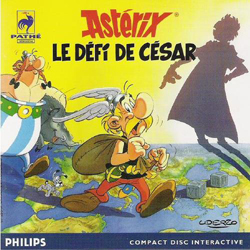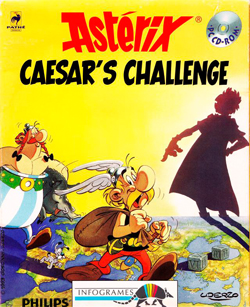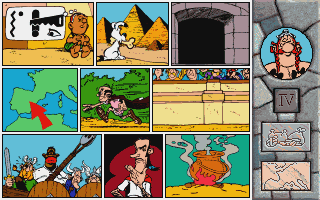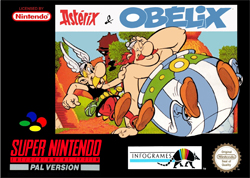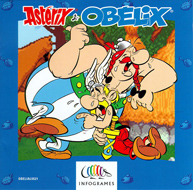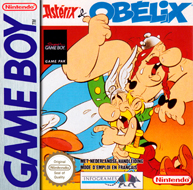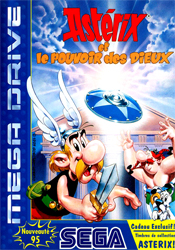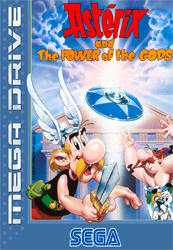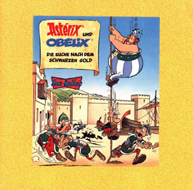
|
Page 1: |
Page 2: |
Page 3: |
Page 4: |
Page 5: |
|
Page 6: |
Page 7: |
Page 8: |
Astérix: le défi de César (Astérix: Caesar's Challenge) was originally developed for the ill-fated Phillips CD-i system. Billed as an interactive educatement game platform and featuring several titles based on TV shows and movies, Astérix would seem to be a good fit, for not only some family friendly fun, but also to teach kids about European history and geography. With Panoramix as your guide, get ready to walk across Europe and collect some ancient relics... and a sausage.
Astérix: le défi de César is best described as an interactive board game. At the beginning of the game you're treated to a well animated intro introducing the characters and story. The story is a blend of elements from Les Douze Travaux d'Astérix and Le Tour de Gaule d'Astérix where Astérix and his friends must travel through Gaul and the surrounding territories and collect relics, treasures and souvenirs. At the start of the game you are given a choice of playing as Goudurix, Obélix, Bonemine, Falbala, Agecanonix or Astérix himself. Since the game takes turns, it allows for six players. The "board" is a layout of interactive windows. Depending on what window you land on, you will have to accomplish certain tasks, or your play piece will either be jailed, hit or moved forward by various events.
The goal is to collect a set number of artifacts that the player chooses before the round begins, which starts at a default number of seven artifacts. The artifacts range from Roman pins, small statues, the Great Sphinx of Giza replica (of which Obélix tore the nose off, according to Astérix et Cléopâtre) and an Italian sausage. The only way to acquire these relics and artifacts is to answer a trivia question, which in most cases relates to Greek mythology and Roman history. These trivia questions are triggered by landing on a landmark window, and you can only get one item per window, so if you land on the same window later and answer correctly, you won't get any prize.
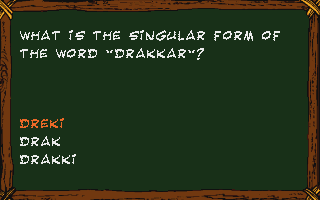
Most of the well known characters of the Astérix universe pop up here in some way or another. Most of the interactive windows trigger some form of mini game that must be finished in order to gain credits, which can be used to break out of jail, and so forth. These mini games are quite a mixed bag, with some being surprisingly fun and other being horribly tiresome. One mini game puts in the role of Cétautomatix avoiding the flying fish thrown by Ordralfabétix, another puts in the running shoes of a frightened Gaul avoiding falling hazards from the sky and you also get to be Kiçàh jumping from carpet to carpet, a game I have never once been able to master. There are also windows where Zéozéosix will help you by letting you use his spy gadgets and go to any square you may desire. You can also get unlucky and land on a square with the evil Roman agent Tullius Détritus which will either take you straight to jail or a few squares back.
An interesting event that's triggered at random is the appearance of Panoramix on screen. At times he will come in and tell the player(s) to take a break with him and join along in a game of his own. These games are truly interactive as they require you to do things in real life rather than in game. Sometimes he will tell you to race to touch the screen first while other times he will ask one of the player to grab the game box. When the music starts, you're supposed to pass the game box around to each player around you and whoever holds it when the music stops will go straight to jail, which Panoramix cheerfully informs you. Of course the game has no way of knowing who actually wins these intermission games and requires the player to select the outcome through an on screen choice. I'm pretty sure this fact has led to some dishonest choices which has broken up siblings and friendships because it's so tempting to just pick someone else rather than yourself when you are the loser. Just with a click of a button you're the winner, after all.
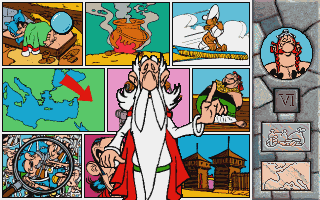
The game looks quite good with some fluid animation and rather high production values for a CD-i game. However it gets stale really fast, as there aren't many different windows to land on and repetition strikes within the first 5 minutes of playing. The voice acting in the English version save for Panoramix is horrendous and barely fits some of the characters, while the French version sounds a lot better with the casts of the cartoons returning to provide the voices. The number of quotes are very limited along with the windows and you'll know all the lines by heart after the first time playing. And I swear, if I hear that "Fresh air is bad for your lungs" one more time, I'll start smoking four packs a day becase this game couldn't tell me that enough, it seems. Die hard Astérix will have fun seeing all the cameos, but the fun won't last more than a few minutes. For everyone else it's just a boring board game which repeats itself instantly. It was later ported to IBM PC and Macintosh computers with no changes other than faster loading times.
Quick Info:
|
Developer: |
|
|
Publisher: |
|
|
Designer: |
|
|
Genre: |
|
|
Themes: |
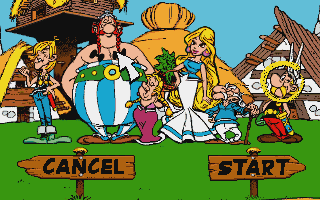
Astérix: le défi de César (IBM PC)
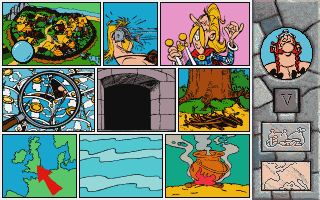
Astérix: le défi de César (IBM PC)
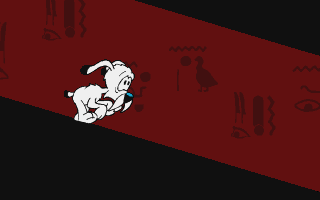
Astérix: le défi de César (IBM PC)

Astérix: le défi de César (IBM PC)
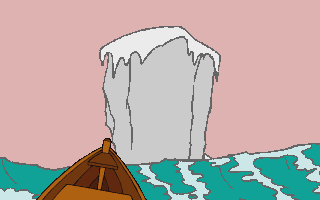
Astérix: le défi de César (IBM PC)
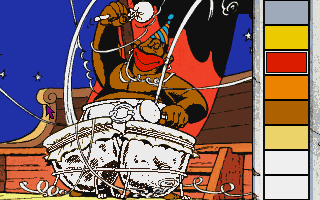
Astérix: le défi de César (IBM PC)
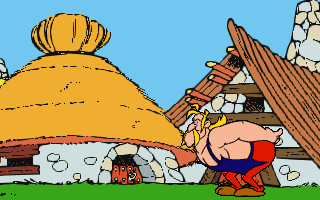
Astérix: le défi de César (IBM PC)
Whenever you have a team of brothers or dynamic duos of any kind, the supporting member of that team up is bound to become the underdog that a big portion of the fan base will embrace and relate to more so than the main character. Over time we've seen games featuring Luigi, Tails and Diddy Kong which established the fact that underdogs do have a loyal fan base which will support the games they star in. Astérix was certainly not excluded from this fact, and Obélix would often be cited as a personal favorite among a big percentage of the fans. Though he had already gotten his own game on the Atari in 1984, video game had evolved since then, and so it was decided to yet again let the blue blob-like Gaul have his own adventure. However for reasons unknown, this game would not always make this fact clear for the fans.
The idea of adapting Le Tour de Gaule d'Astérix into a video game was apparently a well recieved premise. Just a few months earlier another game had been released on Phillips CD-i with that storyline as its backbone, and now this game would do the exact same. Due to not being able to defeat the Gauls, César has decided to build a palisade around the little village in order to keep them locked in and unable to interfere with his invasion. Astérix and Obélix are not intimidated by this and decide to play César for a fool by breaking free from the barricade, traveleing to all the occupied countries and find one souvenir. When they have collected them all, they will send all the items to César as a gift to show that they traveled all over his empire without any problem. While the CD-i opted for a mediocre board game to get this story across, Astérix & Obélix goes back to a sidescrolling platformer with lots of action.
Development duties were given to Bit-Managers, who had already been responsible for the NES and Game Boy versions of 1993s Astérix. Bit-Managers had a good track record on Game Boy where most of their games would see a release, but Astérix & Obélix would be their only effort on the SNES. It's a rather long game with 27 levels and 16 mini-games of many kinds, though most of them rely on the same mechanics used in-game. The progress of the game is what had been established with the majority of the earlier Astérix games, a voyage through many countries with different environmental hazards appropriate for its climate. The game allows for 2 players simultaneously, a first for a console Astérix and a sorely missed feature since the arcade game. The only major difference between them is the size and speed of their movement and attacks, but none of them have any individual skills. Many refer to this game as a port of the arcade game but other than co-op gameplay it bears little resemblance and do not have any connection outside of being of the same license. Sadly, despite offering a real 2 player mode and some impressive graphics for SNES, it's a quite bumpy ride getting to Rome. The controls have some delay to them, which makes the fighting tedious, and it continues the strange tradition of making the heroes uppercut straight up, limiting your reach significantly. Worse yet is that the majority of enemies you meet can attack you from a distance while you have to be right by the side of them, leading you to take first damage most of the time. Obélix also controls so slowly that despite being the default choice, there very little reason to play as him.
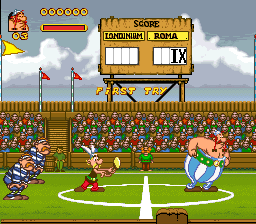
Astérix & Obélix (SNES)
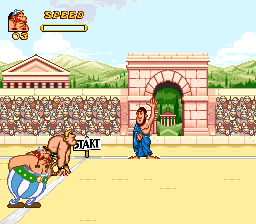
Astérix & Obélix (SNES)
Items and points are scattered around the stages in true platforming fashion. You can pick up stars for points, and depending of your choice of character, you can also obtain a magic potion/roasted boar for temporary star power. What sets this game apart from the others is the high number of bonus stages you will encounter. After almost every other level or so, there will be some kind of bonus stage such as playing rugby or running in the Olympic games. While it offers a much needed breather from the standard action found in the game, they all base themselves on the same mechanics you already use on the normal stages for the most part. A few of them require some button mashing and other styles of control, but for the most part it's all about jumping and punching which makes it more of the same. It's not horribly executed, and to its credit most these stages work well, but they just don't offer enough to keep the game from feeling a bit redundant if you've already played any other platformer.
Alberto González returned to the franchise to score this game, and it would also be his first (and only) soundtrack on SNES. While quite enjoyable, it is much more subdued than his earlier works on NES and Game Boy.
The strangest part is the naming of the game, Astérix & Obélix. Sure both characters are featured and indeed you can play as both, but the game was marketed and clearly shows a favoritism towards Obélix. By default you start as him, the intro shows him goofing around and his logo is three times the size of Astérix's logo on the packaging and even in the game itself. It gets even more puzzling as all the ports and releases that game after the initial SNES and PC versions are named just simply Obélix in-game, but the packaging still reads Astérix & Obélix. This might have been done because of sales concern by just marketing Obélix but especially in the case of the portable version, it gets confusing why the titles differ.
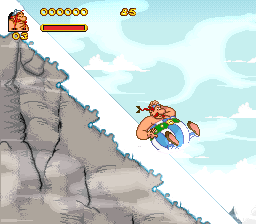
Astérix & Obélix (SNES)
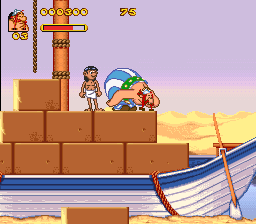
Astérix & Obélix (SNES)
The Game Boy version also offers the most interesting challenge and gameplay out of all the versions released of Astérix & Obélix. While there was a PC port released, it merely increased the resolution while being a straight port of the SNES game. The Game Boy game is completely different. As mentioned, the packaging refers to this game under the SNES title, but once you boot up the game it will only read Obélix. You can choose to control Astérix, but he's not the intended hero of this title. This was actually the lead version developed with SNES following, though depending on where you lived, it was released later than the SNES version. The SNES version does feel a bit rushed, and it might be because the decision to make a 16-bit version was made a bit late in development, though at this point it's only an educated guess. The Game Boy game feels much more polished and features some fluid controls, great graphics and another excellent soundtrack by Gonzales who clearly pushed a lot more out of the Game Boy than he did with the SNES. While the story and levels are the same, the layouts are completely different and only share aesthetic similarities. A number of the bonus stages are included too, though they are fewer and further apart. It was also one of the Game Boy games that seriously benefited from the Super Game Boy as it would give you a nice banner and make the stage objects more distinguishable. The game would also see a re-release in 1999 on the Game Boy Color, while the SNES version would be released on the Game Boy Advance as part of the 2-pack Astérix & Obélix Bash Them All. The GBA version has brighter colors and is made easier as every Roman now only takes one hit to dispose of, while the rest of the game remains the same as its SNES parent. This game would also feature the the box trade-in promotion at Parc Astérix.
Quick Info:
|
Developer: |
|
|
Publisher: |
|
|
Designer: |
|
|
Genre: |
|
|
Themes: |
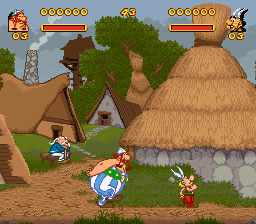
Astérix & Obélix (SNES)
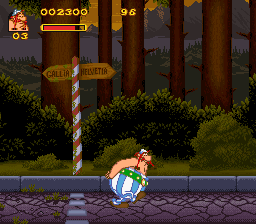
Astérix & Obélix (SNES)
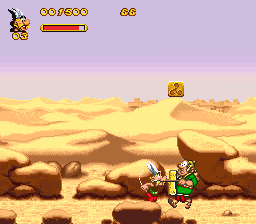
Astérix & Obélix (SNES)
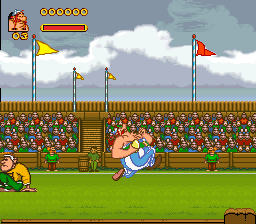
Astérix & Obélix (SNES)

Astérix & Obélix (SNES)
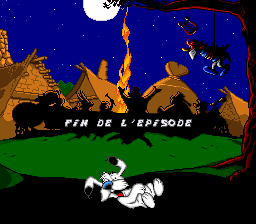
Astérix & Obélix (SNES)
Screenshot Comparisons
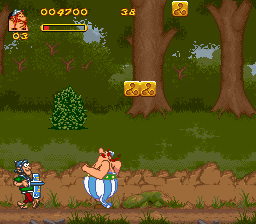
SNES

Windows
Game Boy Advance
Game Boy
Super Game Boy
Game Boy Color
Astérix strangely always had a nature of jumping back and forth to different developers, which always resulted in semi-sequels to different games which all had quite big gaps in quality. Core had their chance earlier in 1991, and in 1995 they would yet again try to slap some sense in those pesky Romans.
Core had rather unsuccessfully tried to adapt the French comic into a platform game with Astérix and the Great Rescue. So when they got a second chance, hopes were that they would bring out a more polished product than what we had already seen, as their overall track record wasn't necessarily a bad one. Astérix and the Power of Gods was released in late '95 in France and early '96 in the rest of Europe. It would be the last 16-bit adventure for Astérix as the next generation of consoles were on the horizon.
Astérix and the Power of Gods would follow the same formula that the other games had mostly been following. Astérix and Obélix are sent out to retrieve the shield that is used to hold up Abraracourcix the village chief. The search takes them through all the corners of the Roman Empire. This basic storyline is taken from the book Le bouclier Arverne (Astérix and the Chieftain's Shield) and the opening cinema actually uses pictures taken directly from the book, which all look very nice obviously. However after the opening cinema, the game follows no strict storyline from any of the books, rather each level representing different adventures. This is all standard stuff by now in the Astérix video game franchise, unfortunately. There is an over world map this time and levels must actually be in a certain order as they often impact each other. You can enter and visit all levels, but some cannot be properly explored until a certain event has been triggered, ala Bionic Commando on NES. An example is that when you reach the end of the Gaul Forest, you fire a catapult with a fire stone inside. This stone travels over to one of the Roman camps and sets it on fire so that you can walk in beyond the gates.

Astérix and Obélix have an increased set of moves in their arsenal since Core's last game. While their normal punch is still a laughable excuse for an attack, you can now grab stunned enemies and perform melee throws that take out all surrounding Romans much like what was introduced in TMNT: Turtles in Time. You can perform different kind of throws with simple button and direction combinations. There are also magic potions and wild boards laying around that give the duo new super attacks. You can also use environmental objects such as crates, cauldrons and massive bowling balls to take out lined up enemies and receive a wealthy amount of points. As for points, you usually pick up coins of varying sizes and fruit, though there are also hidden gems that cannot be seen but if you touch them, a huge number pops up onscreen with the amount of points it has given you. At the end of most levels, you will either obtain an object or speak with a character that will tell you where to go next, though at times their dialogue is a bit confusingly written and you'll won't be any smarter from the chit-chat.
The game featured quite a wide variety of levels but it doesn't take too long before they feel very similar to one another. Everything is out to kill you, even more so than before. The enemies are quite cheap and lead to some fury inducing moments. Romans come in different shapes and sizes. The most common enemy is the normal troops which you'll find standing around. Their primary attack is running into you, which they'll most likely succeed in as your attack requires them to be pixel dot next to you. The worst are those outside of view. Romans can shoot arrows, rocks, fire balls, anything you can think of at you without being in sight and plenty of these objects are instant kill. Even wild boars kills you instantly. The level layout is for the most part acceptable but too many of them run their concepts into the ground. Even the Gaul village, which acts as a points and health refill spot, is massive and has 5 different paths to take with none of them ever being necessary to visit. You can also be killed in the village by running into bonfires or moles with rage issues, which is quite annoying when you run low on life and energy. The level design is at times very good and feels fresh with scaling effects and puzzles a-plenty, but all the cheap deaths you'll encounter will keep you from exploring them too much for treasures. The Pirate Boat is probably the best level in the game as it uses a special scaling effect that makes the ship rotate around. During this level, the screen shrinks in size in order to properly do this effect at full speed.
It really seems as if all the Astérix video game developers slept on the job when it comes to the last stretches of the game. Like in the SNES game, this one also features no end boss, no end puzzle, just find the shield in a treasure chest beneath the Roman bath. Just pick it up and the screen fades out. It was such an anticlimactic moment that it completely passed me by and I nearly prepared to assault my controller before realizing that the ending cinema was starting to roll. The last stage is probably the easier in the whole game because it barely has any cheap kills or large enemies. It's a bizarre feeling to just stroll through the last level of a game and have it feel so non-threatning.
The graphics are more colorful and fairly faithful to the look of Astérix compared to what Core put out with in The Great Rescue, but there still an element of awkwardness to them despite the boost of quality. The characters look more like crude caricatures than faithful representations of their source material, and the animation doesn't resemble at all their way of movement found in the books or movies. The music is done by Core's Neil McGree and includes some catchy tunes as well as classical music which doesn't really sound too good on the Genesis's FM chip.
It's certainly not the worst Astérix game out there, and it does some rather nice things for a Genesis game thanks to being released fairly late in its life cycle. The game is just simply not generous enough and makes no effort to invite players to actually take their times to seek out the hidden treasures and points to find because it will lead you to death. Finding all the treasures also brings little reward, with the only difference being that you get the highest score on the leaderboard for others to beat. Had it done more with the world map system and given you enough extra lives, it would have been a much better game, but in the end, it's just a very linear, very difficult platformer which teases the feeling of self control over the progress. This would also be the last game to feature the Parc Astérix promotion.
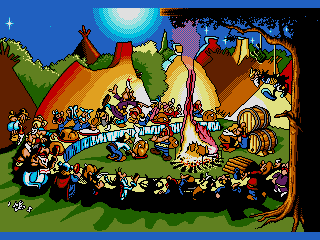
Quick Info:
|
Developer: |
|
|
Publisher: |
|
|
Genre: |
|
|
Themes: |
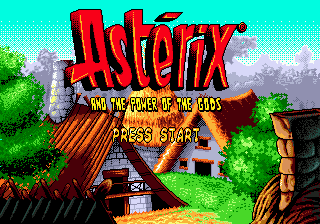
Astérix et le pouvoir des dieux (Mega Drive)
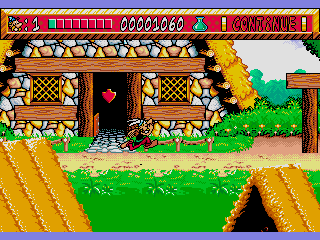
Astérix et le pouvoir des dieux (Mega Drive)
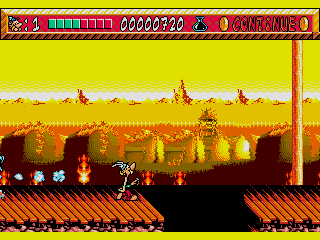
Astérix et le pouvoir des dieux (Mega Drive)
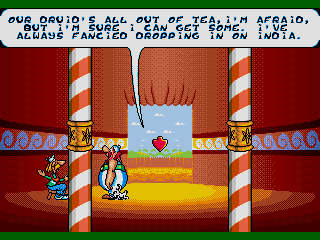
Astérix et le pouvoir des dieux (Mega Drive)
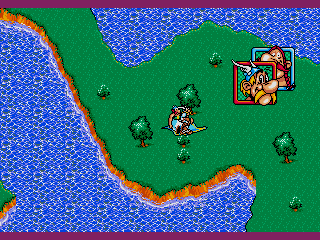
Astérix et le pouvoir des dieux (Mega Drive)
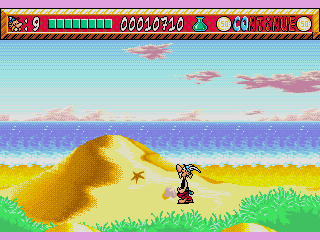
Astérix et le pouvoir des dieux (Mega Drive)
This rare German only release actually goes back to a comic that once before was also featured in a German exclusive game. Die Suche nach dem Schwarzen Gold is an interactive comic book that tells the story of L'Odyssée d'Astérix (Astérix and The Black Gold), which was also the story told on C64 almost 10 years earlier in Astérix und Obélix: Die Odyssee. This time it was done by Egmont Interactive, traditionally a comic book and magazine publisher.
Not much info can be found on this title outside of what is stated on a few German websites. The game features the comic in its entirety told through the comic panels with full narration and sound effects. At certain points in the story, it will give you the choice of playing a mini-game based on the current events taking place in the story telling. Altogether there are six of these games, "The Hunt for Wild Boar", "The Pirates' Competition," "Sink the Ships", "The House of Edifis," "At the Gates of Tyre " and "The Barrels of Luck." Most of these only require you to move whatever playable object you have been assigned left or right like an old LCD game. In addition to the comic and games it also includes an encyclopedia of Astérix terms, locations, characters and history pieces, being clearly geared towards the youngest of gamers. The narration is offered in French, German and English, despite the game being only released in limited quantity in Germany. After the story is finished, you will get a high score which other gamers can challenge.
There's little to no praise to be found by the few "lucky" players who have been able to play this. They all in unison cite terrible picture quality, amateur voice actors for all the languages, overly simplistic and boring games and an incredibly small and insufficient encyclopedia feature which excludes major characters and events. Considering the prices some second hand sellers are asking for the game and the assumed low quality of the product, it's probably one game that is best left rare and undiscovered.
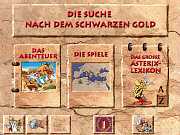
Astérix & Obélix: Die Suche nach dem Schwarzen Gold (Windows)
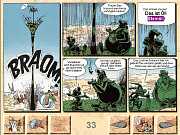
Astérix & Obélix: Die Suche nach dem Schwarzen Gold (Windows)

Astérix & Obélix: Die Suche nach dem Schwarzen Gold (Windows)
|
Page 1: |
Page 2: |
Page 3: |
Page 4: |
Page 5: |
|
Page 6: |
Page 7: |
Page 8: |
